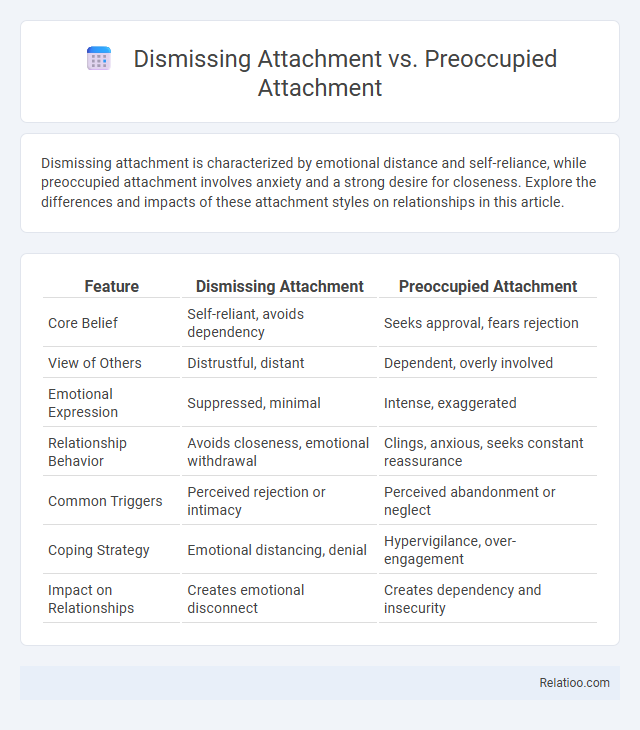Dismissing attachment is characterized by emotional distance and self-reliance, while preoccupied attachment involves anxiety and a strong desire for closeness. Explore the differences and impacts of these attachment styles on relationships in this article.
Table of Comparison
| Feature | Dismissing Attachment | Preoccupied Attachment |
|---|---|---|
| Core Belief | Self-reliant, avoids dependency | Seeks approval, fears rejection |
| View of Others | Distrustful, distant | Dependent, overly involved |
| Emotional Expression | Suppressed, minimal | Intense, exaggerated |
| Relationship Behavior | Avoids closeness, emotional withdrawal | Clings, anxious, seeks constant reassurance |
| Common Triggers | Perceived rejection or intimacy | Perceived abandonment or neglect |
| Coping Strategy | Emotional distancing, denial | Hypervigilance, over-engagement |
| Impact on Relationships | Creates emotional disconnect | Creates dependency and insecurity |
Understanding Attachment Theory
Dismissing attachment is characterized by emotional distance and a tendency to minimize the importance of relationships, while preoccupied attachment involves heightened anxiety and dependency on others for validation. Reflective functioning refers to the ability to understand and interpret one's own and others' mental states, playing a crucial role in moderating attachment behaviors. Understanding attachment theory involves recognizing how these attachment styles and reflective functioning patterns influence interpersonal relationships and emotional regulation.
What is Dismissing Attachment?
Dismissing attachment is characterized by a tendency to downplay the importance of relationships and maintain emotional distance, often resulting in self-reliance and avoidance of intimacy. Individuals with dismissing attachment typically suppress their feelings and distrust others' intentions, which can impact your ability to form secure and connected bonds. Understanding this attachment style alongside preoccupied attachment and reflective functioning helps clarify how emotional regulation and interpersonal dynamics influence psychological well-being.
Key Traits of Dismissing Attachment
Dismissing attachment is characterized by a strong sense of independence, emotional distance, and a tendency to downplay the importance of close relationships, often leading to difficulty in trusting others and expressing vulnerability. Key traits include a positive self-view combined with a negative view of others, a preference for self-reliance, and suppression of emotional needs, which contrasts with the anxious, needy behavior seen in preoccupied attachment. Understanding your dismissing attachment style can enhance your reflective functioning by helping you recognize and regulate emotional responses and foster healthier interpersonal connections.
What is Preoccupied Attachment?
Preoccupied attachment is characterized by a heightened desire for closeness coupled with anxiety about relationships, often leading to dependency and fear of abandonment. Your emotional state is frequently influenced by others' opinions, making it challenging to maintain a stable sense of self. This attachment style contrasts with dismissing attachment, which involves emotional distancing, and is linked to lower reflective functioning, the capacity to understand one's own and others' mental states.
Key Traits of Preoccupied Attachment
Preoccupied attachment is characterized by high anxiety about relationships, leading to intense neediness and fear of abandonment, often resulting in emotional hyperactivation and dependency on others for self-worth. This attachment style contrasts with dismissing attachment, which involves emotional suppression and independence, and is less influenced by others' approval. Reflective functioning, or the capacity to understand mental states in oneself and others, is often impaired in preoccupied attachment, causing difficulties in emotion regulation and perspective-taking within relationships.
Dismissing vs Preoccupied Attachment: Core Differences
Dismissing attachment is characterized by a tendency to maintain emotional distance and suppress attachment needs, while preoccupied attachment involves hyper-sensitivity to relationships and fear of abandonment. Your ability to regulate emotions and perceive others' intentions differs significantly between the two, with dismissing individuals often avoiding intimacy and preoccupied individuals seeking constant reassurance. Reflective functioning, or the capacity to understand mental states in oneself and others, plays a crucial role in moderating these attachment styles and enabling healthier relational patterns.
Impact on Adult Relationships
Dismissing attachment often results in emotional distance and difficulty expressing intimacy, leading to challenges in forming close adult relationships. Preoccupied attachment is characterized by anxiety and fear of abandonment, causing heightened dependency and conflict in partnerships. Reflective functioning enhances the ability to understand one's own and others' mental states, promoting healthier communication and emotional regulation within adult relationships.
Emotional Regulation in Both Attachment Styles
Dismissing attachment is characterized by emotional suppression and avoidance, leading to difficulties in recognizing and regulating feelings, whereas preoccupied attachment involves heightened emotional sensitivity and hypervigilance, often resulting in overwhelming emotional responses. Reflective functioning enhances emotional regulation by enabling individuals to understand and interpret their own and others' mental states, fostering healthier coping mechanisms. Your ability to develop reflective functioning can bridge the emotional regulation gaps found in both dismissing and preoccupied attachment styles.
Overcoming Attachment Challenges
Overcoming attachment challenges involves recognizing the distinct patterns of dismissing attachment, characterized by emotional distancing, and preoccupied attachment, marked by anxiety and dependency. Enhancing your reflective functioning--the capacity to understand and interpret your own and others' mental states--plays a crucial role in shifting these attachment styles toward healthier relationships. Developing increased self-awareness allows you to break maladaptive cycles, fostering secure connections and emotional resilience.
Therapeutic Approaches for Attachment Issues
Therapeutic approaches for dismissing attachment emphasize building trust and encouraging emotional expression through techniques like mentalization-based therapy (MBT) to enhance reflective functioning. Preoccupied attachment benefits from interventions such as cognitive-behavioral therapy (CBT) and emotion-focused therapy (EFT) aimed at regulating intense emotions and improving relational boundaries. Enhancing reflective functioning across attachment styles is central in treatments, fostering greater self-awareness and mentalizing capacity to support healthier interpersonal relationships.

Infographic: Dismissing Attachment vs Preoccupied Attachment
 relatioo.com
relatioo.com